
Indonesia
Wayang purwa puppets
Java, Indonesia. 20th century
Buffalo hide, cut and painted.
Height 43 cm and 50.5 cm. Inv. Nos.3950 II, 3880 II
Received in 1965 from the Kremlin Museums, Moscow.
The wayang purwa shadow theatre is among the favourite public spectacles in Indonesia, particularly on the isles of Java, Bali and Madura. Indonesian puppet shows are the oldest of their kind in the whole of South-East Asia. According to written records, they have been known since the 11th century. Their significance in the life of the islanders is enormous. Due to their ritual origin, the wayang purwa shows have traditionally been interpreted by the Indonesians as bearing the message of well-being and good luck. The puppeteers (dalangs) perform such shows at night, timing them to the important dates in the life of people: a birth of a child, its first steps, the maturity of a son or daughter, their marriage, assumption of an office, death, etc. In other words, the wayang purwa shows accompany the Indonesians throughout their lives.
The full list of figures in the wayang purwa theatre contains over two hundred characters. Each of them is endowed with a distinct appearance to ensure its recognition on the screen. The entire list of characters traditionally falls into three categories: virtuous and noble characters (deities, princes, rajahs, hermits, etc.), villains and evildoers (demons, monsters, wicked giants, etc.) and characters of an intermediate type (fearless warriors of indomitable and ruthless nature, etc.). Noble characters have a matchingly stylized appearance: the bodies and limbs are elongated almost to the point of being grotesque, the facial features are refined and delicate. The demoniac images are easily identified by their monstrous look. Their ugly bodies are short and bulky, they are goggle-eyed, short-nosed and have sharp fangs sticking out of their mouths. Most shows of the wayang purwa theatre are staged on the basis of the great Hindu epics Ramayana and Mahabharata.
Wayang golek puppets
Java, Indonesia. 20th century
Carved and painted wood, fabric.
Height 67.5 cm and 66 cm. Inv. Nos. 3898 II, 3897 II
Received in 1965 from the Kremlin Museums, Moscow. First publication.
The immensely popular wayang purwa shows inspired the appearance of other theatrical shows. Among the most popular is the wayang golek puppet theatre. Its origin on Java presumably goes back to the 14th or 15th century, i. e. to the most prosperous period in the history of the Majapahit Empire- the last Hindu state on Java. Unlike the wayang purwa plays, these shows have no ritual or mystic significance and are staged in the daytime. In the east of Java and on Bali the performances are based on the Hindu epics Ramayana and Mahabharata, and in the western part of Java, where the Islamic influence is stronger than elsewhere in Indonesia, the main character of the wayang golek shows is Amir Hamzah-a brave warrior, with fire and sword asserting the faith of Allah. Another source for the wayang golek performances are various folk legends and tales with Prince Pandji as the main character.
Both the virtuous and vicious characters of the wayang golek puppets have much in common with the marionettes of the shadow theatre. The similarity is so strong that the wayang golek puppets seem to be flat cutouts which have suddenly acquired a third dimension. The faces of the puppets are painted in accordance with the canon attributing certain features to each type of character. The lower part of their bodies is draped in batiks imitating the traditional Indonesian costume.
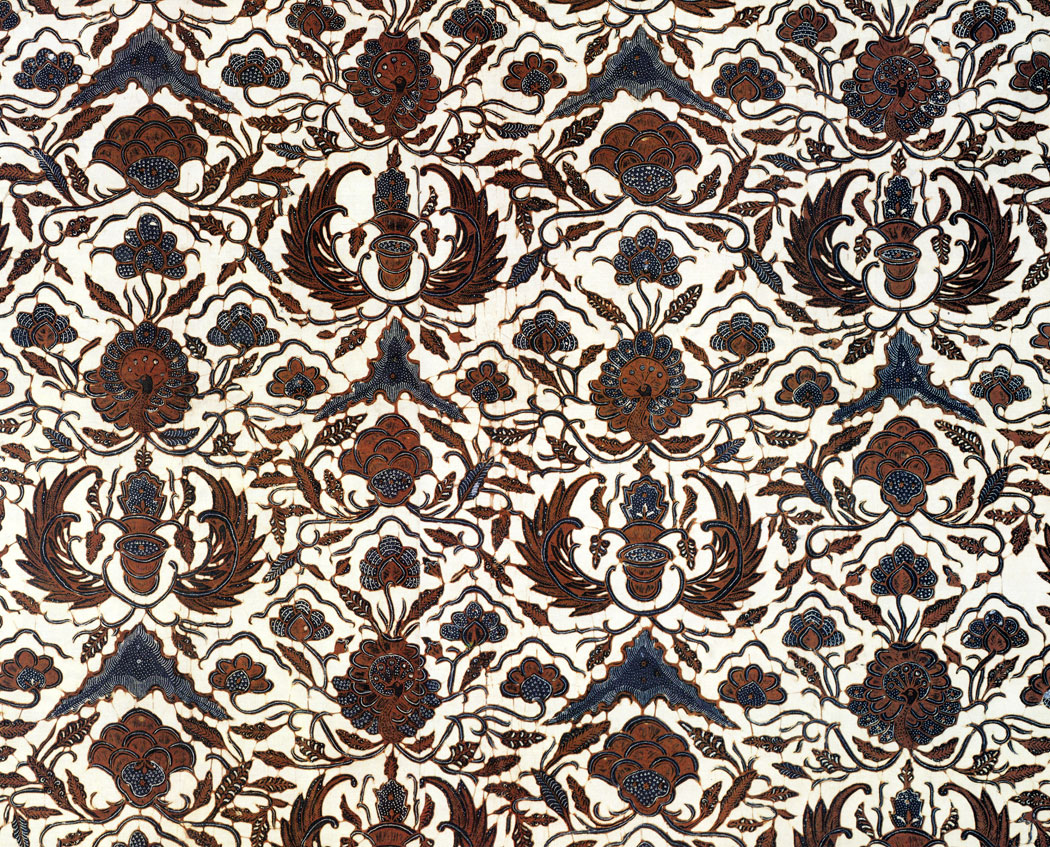
Batik
Java, Indonesia. 20th century
Cotton.
250 × 108 cm. lnv. No. 4605 II
Received in 1965 from the Kremlin Museums, Moscow.
Central Java, especially the environs of Surakarta and Jogjakarta, is world-famous for its batiks-cotton fabrics with the designs produced by a negative dyeing method. In this method the designs are marked out in wax before the fabric is dipped so that the wax portions do not take the dye and stand out in the original colour of the fabric. The Javanese technique of batik-designing has been elaborated to perfection, and the quality of fabrics is excellent. In short, Javanese batiks are superior to all other examples of their kind produced elsewhere. Their designs are renowned for their beauty and diversity, the ornamental repertory amounting to ten thousand motifs. Many of these go back to remote antiquity (Late Stone and Bronze Ages) and have reached us almost intact. The commonest type of ornamentation is based on plant designs which sometimes ingeniously incorporate figures of animals and birds.
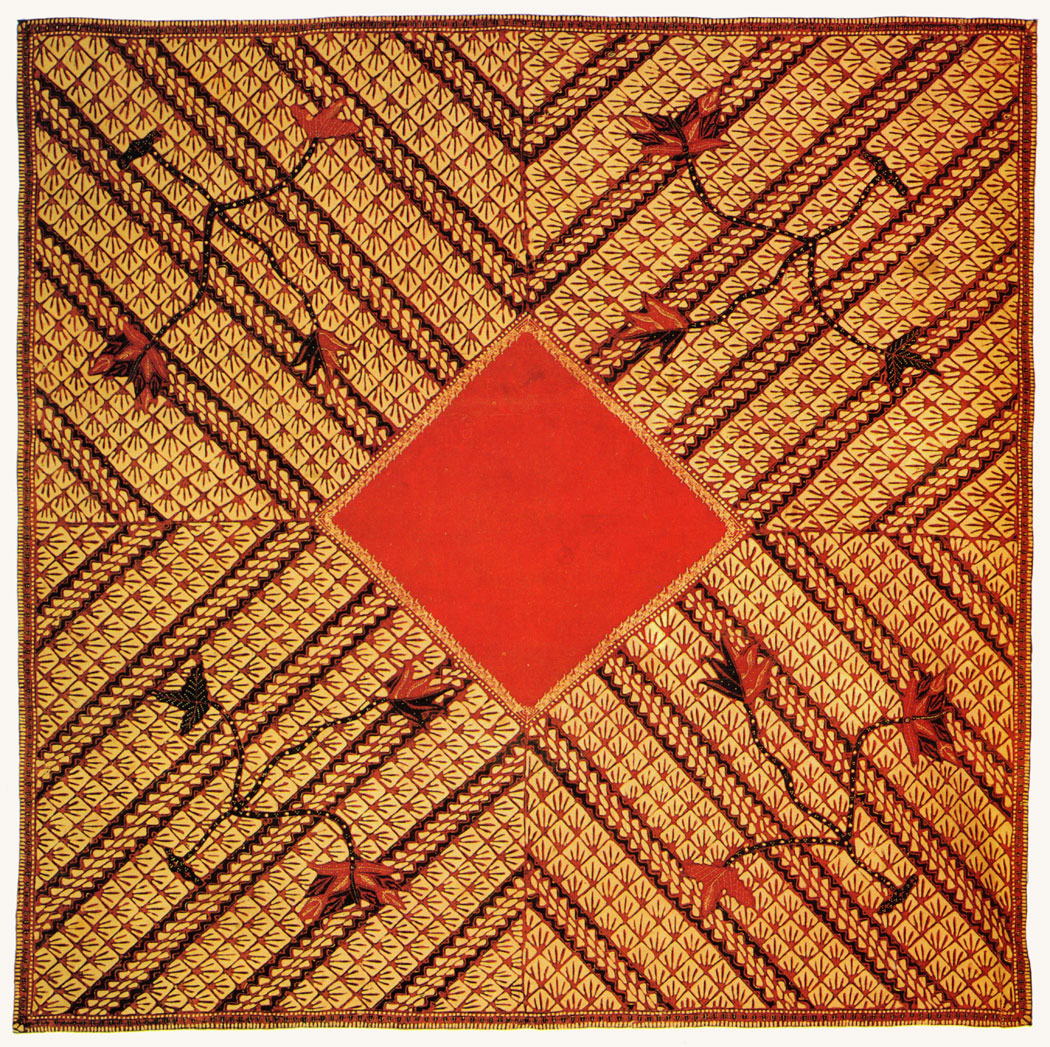
Kerchief (batik).
Java, Indonesia. 19th century
Cotton.
105.5 × 105.5 cm. Inv. No.4187 II
Received in 1961 from the Board of Art Exhibitions and Panoramas attached to the USSR Ministry of Culture, Moscow.
Javanese batiks decorated with floral designs are usually referred to as classical ones, since the experts believe that the technique employed in their production has remained unchanged throughout many centuries. The colour scheme of the classical batiks consists of three main colours-blue, brown and white (the natural colour of the fabric). The prevalence of the velvety-brown colour accounts for a particularly noble colour effect. A recurrent ornamental pattern is lung (sprout), one of a wide range of beautiful floral motifs. It can be seen in the corners of this man's kerchief as a plant whose stem branches off into three slender shoots against a background of diagonal stripes decorated with exquisite geometric patterns (grains of rice, claw marks). The central square is bordered with a band of flame-like floral pattern, or chemukiran. The lung pattern sometimes consists of a bush with many branches, its blossoms and leaves filling in the entire surface of the fabric.
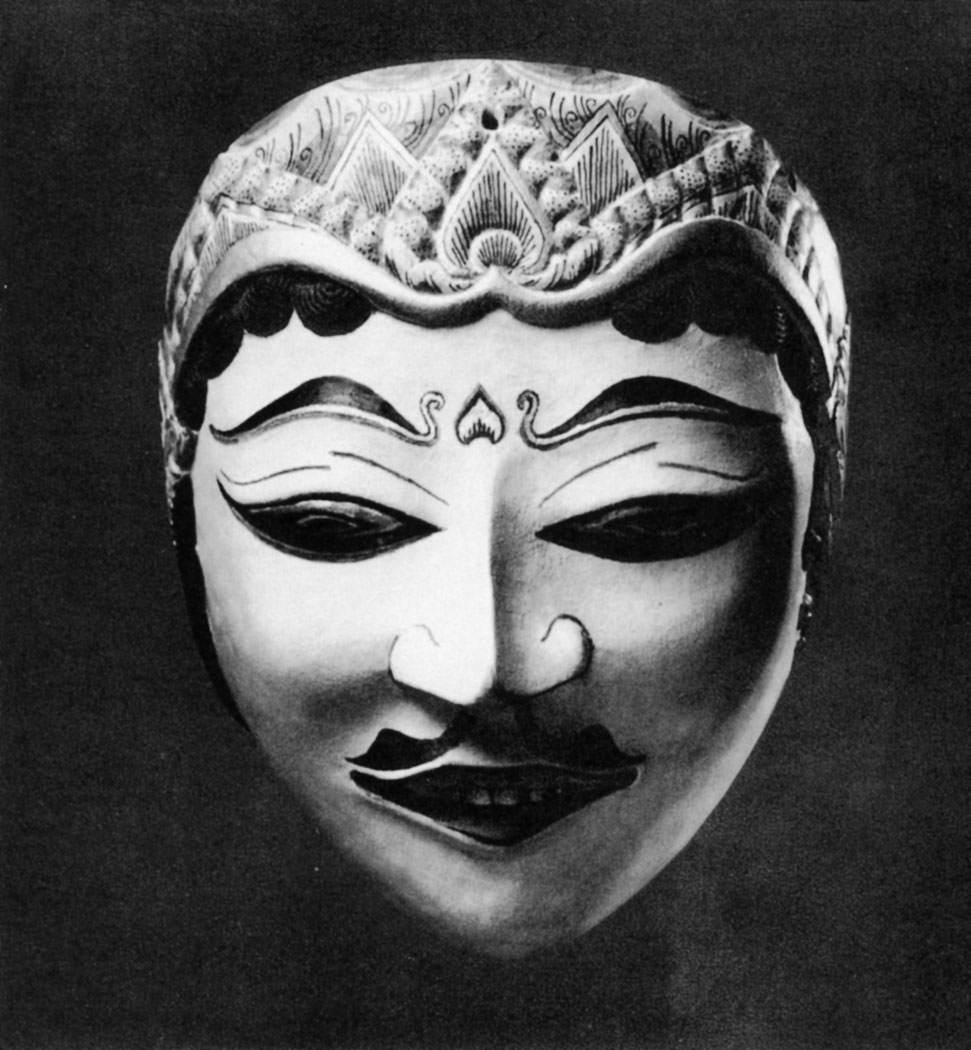
Masks of the wayang-topeng theatre
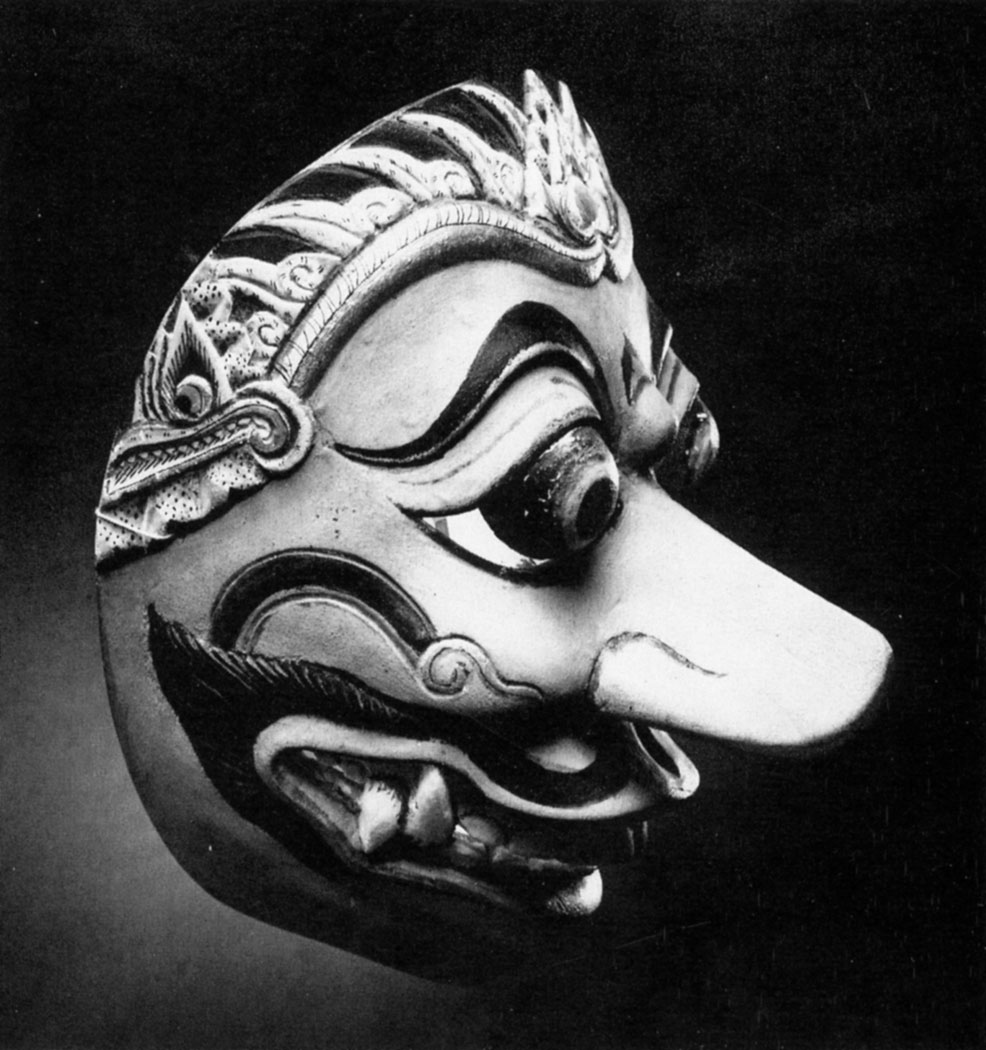
Masks of the wayang-topeng theatre

Masks of the wayang-topeng theatre
Java, Indonesia. 20th century.
Wood, carved and painted.
Height 16.5 cm and 18.5 cm. Inv. Nos.4334 II, 4333 II
Received in 1965 from the Kremlin Museums, Moscow.
The wayang-topeng dance-and-drama shows performed by masked actors are a common public spectacle in Indonesia, particularly on Java and Bali. These shows are based on Ramayana and Mahabharata-the epics which found their way to the islands with the advent of Hinduism in the first centuries AD. It is likely that the wayang-topeng shows became particularly popular in the 14th century, which saw the flourish of the Majapahit Empire-a powerful Hindu state in Central Java. The masks appear in two basic types personifying noble and evil characters respectively. Masks of the first category are identified by their exquisitely stylized, refined and somewhat elongated features. The canon was certainly derived from the conventional iconography of the wayang purwa shadow theatre, which foredated the appearance of the wayang-topeng tradition by several centuries. The canonical type of the evil characters, or demons, with their goggling eyes, flat thick noses, long sharp fangs, etc., goes back to the same source.

Krises
Bali, Java, Indonesia. 19th century
Hammered metal and carved wood.
Length 55 cm. lnv. No. 4267 II
Received in 1962 from the Board of Art Exhibitions and Panoramas attached to the USSR Ministry of Culture, Moscow.
Length 49 cm. Inv. No. 1746 II
Acquired in 1919 from a private collection. First publication.
The kris is an ancient traditional weapon of the Indonesians. On the basis of the vestiges of old Javanese architecture (architectural sculpture and wall-reliefs) and written records, the origin of krises is dated from the 14th century. This legendary weapon, endowed by the Indonesians with a magic power, was made of local iron with the addition of numerous alloys of different metals. Krises differ from other daggers in several characteristically local features-the wavy shape of the blades, widening at the grip, and the shapes of the grips themselves designed as miniature representations of pagan Hindu deities (particularly widespread on Bali and East Java), or of demons and animals, both real and fantastic. Very often such grips are genuine masterpieces of decorative art. In the majority of instances they are carved of precious ivory or horn. At the same time the blades and grips of krises designed for high-ranking people were often made of gold, silver or the alloy of these two metals. They performed a heraldic function and indicated the social status of their owners.
Vishnu
Bali, Indonesia. 20th century
Carved wood.
Height 55 cm. Inv. No. 3953 II
Received in 1962 from the USSR Ministry of Culture, Moscow. First publication.
Bali holds a special position within Indonesian culture since it is the only part of the country with any vestiges of Hinduism (though it is rather a specific form of Hinduism) still remaining. Bali is only a small island, but it is world-famous for the artistic talents of its inhabitants. Their main preoccupation in life is agriculture, but in their spare time they reveal a host of various creative gifts. They are fine singers, dancers, musicians, artists and wood-carvers. The women are particularly skilful in weaving and wicker-work. So it is not without reason that this land is described as "an island of music and dancing" or "an island of crafts and craftsmen". It is on Bali that the most skilful wood-carvers in the whole of Indonesia live. The art of wood-carving has been known there since time immemorial. Its popularity has increased overwhelmingly since the 1930s when the wood-carvers' repertory, which had previously mostly confined to ritual objects, extended to include various secular articles. However, the long-favoured traditional subjects and characters of Hindu legends and folk tales have not lost their appeal for Balinese craftsmen. A vivid illustration is this composition representing Vishnu who is rescuing the goddess of the Moon Devi Ratih. The group, executed in mahogany, illustrates a Hindu legend interpreting the lunar eclipse: a dragon-like monster, the demon Kalu Rahu, is about to devour Devi Ratih, the goddess of the Moon. The statuette is remarkable for its ingenious composition-all the figures are arranged in such a way as to form a real ensemble. It is a fine example of contemporary treatment of a traditional mythological subject.
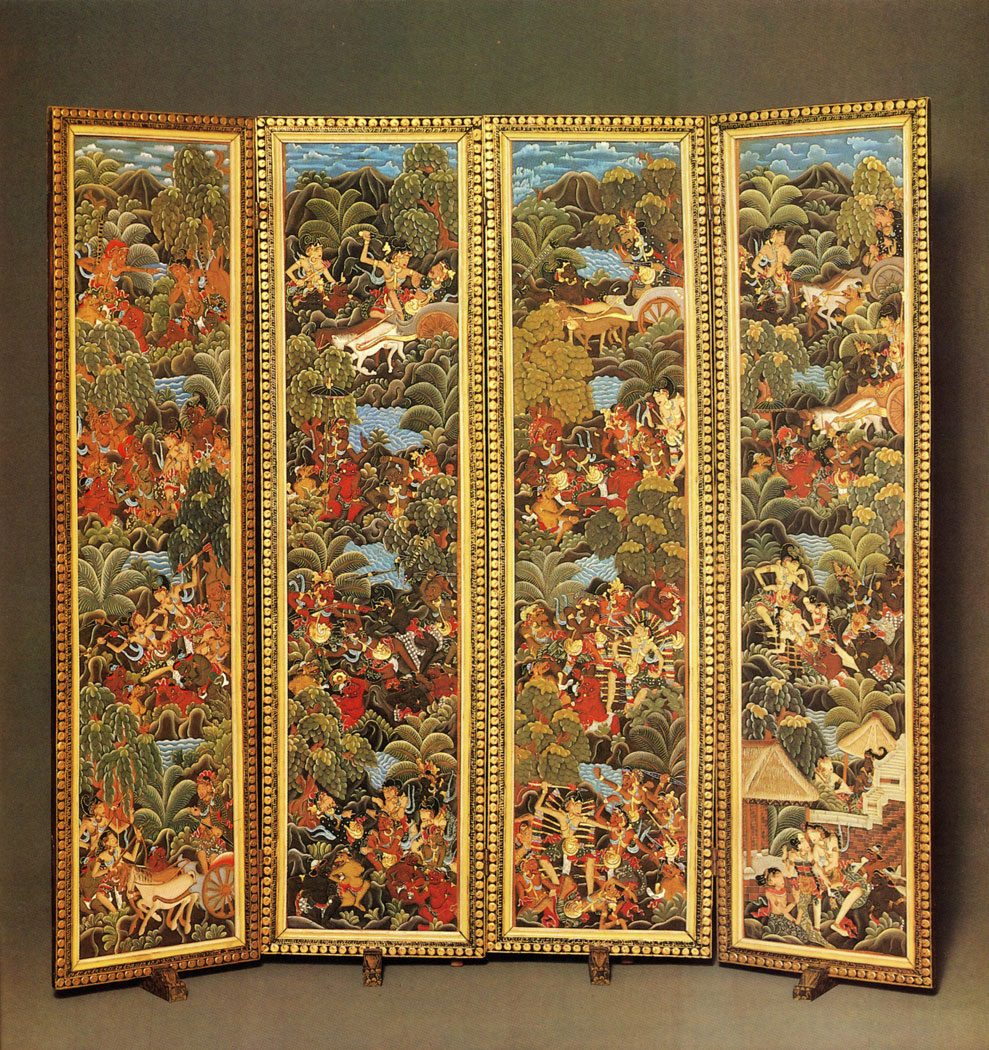
Folding screen
Bali, Indonesia. 20th century
Wood, carved and painted.
165.5 × 150 cm. lnv. No. 4311 II
Received in 1961 from the State Committee for Foreign Economic Relations, Moscow. First publication.
Bali is famous for the versatile and original forms of folk art traditionally practised there. Standing out among them is the art of decorative wood-carving. Large wood-carved panels have been made by the Balinese craftsmen for a variety of purposes: some panels are used as interior wall decorations, others function as screens and partitions or else are used for ritual purposes. Many of these carved screens painted in gay and brilliant colours are genuine masterpieces of this original art. A characteristic example is this four-leafed folding screen decorated with carved designs based on the Mahabharata. They represent some of the most tragic episodes of the Mahabharata dealing with the bloody hundred-day battle between the cousins, the noble Pandavas and the treacherous Kauravas. The brightly coloured and skilfully arranged painting covers the entire surface of the screen. The colour scheme is based on various shades of green-from deep emerald to delicate aquamarine. The battle scenes proper are separated from one another by a series of rhythmic "pauses", provided by what could be termed architectural and landscape elements. On the whole, the screen strikes us as an exceptionally picturesque and colourful sight, while the pictures please the eye with their clear rhythm, a perfect balance of all the pictorial elements and the nobleness of colour combinations.
Peasant at Work
Bali, Indonesia. 20th century
Carved wood.
Height 26.5 cm. lnv. No. 4346 II
Received in 1964 from the Board of Art Exhibitions and Panoramas attached to the USSR Ministry of Culture, Moscow.
Among the numerous stylistic trends characterizing the contemporary Balinese artistic scene, the realistic tendency is definitely one of the most prominent. Balinese sculptures and wood-carvers frequently turned to the world about them for their subject matter and inspiration. Apart from the more joyful facets of life, the artists are also interested in its harder and less pleasant aspects, e.g. the daily toil of Balinese peasants cultivating their land.
This statuette, executed in mahogany, can be justly regarded as one of the best examples of this genre. The carver manages to capture the tense posture and movements of a man working the stony hard soil. The old peasant's wizened body and the deep furrows on his face are rendered without any unnecessary exaggeration; the thorough polishing of the surface does not interfere with the minute details and forms. The statuette portrays a certain type of Balinese, once chosen by the craftsman and then repeatedly used by him in different works.
Heron, Shrimp and Crab
Bali, Indonesia. 20th century
Carved wood.
Height 30.5 cm. lnv. No. 4347 II
Received in 1955 from the Board of Art Exhibitions and Panoramas attached to the USSR Ministry of Culture, Moscow.
Contemporary Indonesian secular wood-sculpture presents a variety of stylistic trends. Some Balinese villages are famous for wood-carving in just one particular genre. Thus, the craftsmen of the villages Sebatu and, especially, Njukuning are known for their works representing animals. The ideas for their sculptures are often provided by folk parables, proverbs, tales and fables. Apart from superb workmanship these pieces frequently demonstrate the carver's keen observation and his knowledge of natural habits and the distinctive features of the animals represented. The group reproduced here illustrates a folk fable about a greedy heron that refused
to share its prey with a crab, which took its revenge by clutching at the heron's neck. The statuette, executed in mahogany, displays both a supple plasticity of forms and a graphic precision of the silhouette due to which it is equally expressive from whatever angle it is viewed.
Harvesting
By Turun. Bali, Indonesia. 20th century
Size colours on canvas.
144 × 90 cm. lnv. No. 4135 II
Received in 1955 as a gift from the Central Committee of the CPSU, Moscow.
Bali stands out among numerous Indonesian islands as the birthplace of a highly original and tradition-based school of contemporary painting. The blend of idyllic and romantic moods and the fairytale atmosphere have always been present in Balinese painting. One of the major distinctive features of this school is the colourful decorativeness of narrative paintings. Balinese artists seem to resent empty space on the canvas and fill its entire surface with a kaleidoscope of exquisite scenes executed in finely chosen colours. Sometimes the stylized figures are treated in a deliberately decorative manner and fill the canvas like elements of an intricate ornamental pattern. An example of such treatment is this painting conceived as a hymn to peasant labour. The canvas is not divided into conventional picture planes. Instead, the figures are brought together in a number of picturesque and rhythmically balanced groups, each of them fitting perfectly into the overall panorama. The brilliant colouring of the picture celebrates the beauty and generosity of nature.
|
ПОИСК:
|
© MUSEUMS.ARTYX.RU, 2001-2021
При использовании материалов сайта активная ссылка обязательна:
http://museums.artyx.ru/ 'Музеи мира'
При использовании материалов сайта активная ссылка обязательна:
http://museums.artyx.ru/ 'Музеи мира'